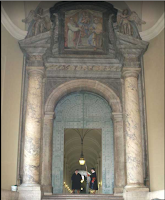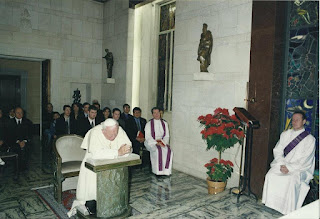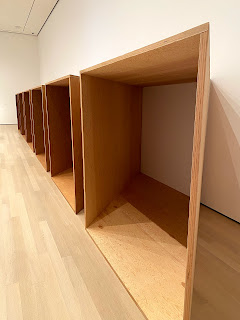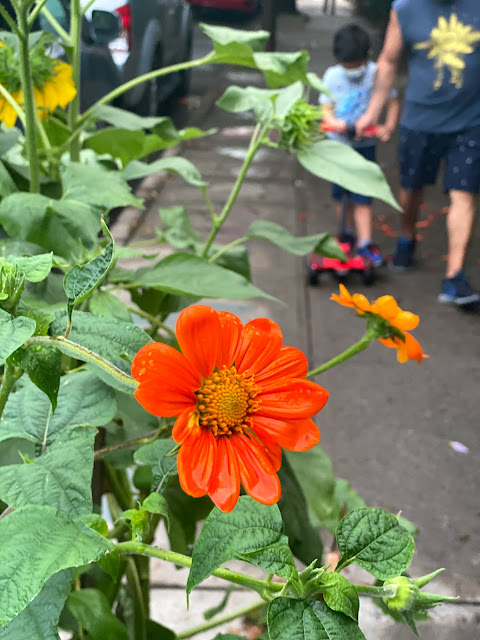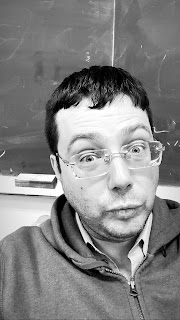Some schools have already been back in session for three weeks now and New York City Public schools have not even started but in our small school in Jackson Heights — we just started this past week. Here's my first day of school report — 2020 edition.
Deep Thought Freeze Frame on Zoom
"I think she's in deep thought," a curly-haired kid in the front row said. "But's she's been like that for a long time." I checked the computer screen — a laptop on the teacher's desk where I could see kids that were learning remotely from home. "Can she hear us?" I asked. ""I think she's frozen, Mr. Roselli." And sure enough, she was. Whatever she needed to say was caught out of joint, still.
That's a snapshot of my first couple of days back at school. I am a high school English teacher at a private school in New York City. About twelve percent of the school has chosen to go remote. The rest of us are at school, wearing masks, properly podded in classrooms, with orchestrated arrival and dismissal times, lunch delivered to classrooms, temperature checks, and everyone in the building has been tested for Covid-19.
A Kind Eighth Grader and a Lesson on Lipids
I start my day before school checking my devices, making sure I don't have a laptop or Chromebook at a low battery level. "Make the first days of school fun," a friend says. But it doesn't feel fun. The excitement of the first day lost its allure this year. In homeroom, I take attendance, but I have to make sure the students who are learning remotely have logged on. Then I have a planning period in the morning. And then, I monitor the eighth-grade study hall. "How are you doing, Mr. Roselli?" one of the eighth-graders asked me, and my heart melts a little bit because I know this kid, and I was touched by her small gesture of empathy. She tells me in a free flow of words how her day has gone, her troubles with Google Classroom, and why soap and water kill the Coronavirus. The whole class then suddenly stops and listens as I give a deliberate explanation of how the cell wall of a coronavirus is made of a lipid layer — and that soap is basically a lipid — and when soap hits the surface of your skin, any virus material that may be on it gets canceled out by lipid action. Soap is basically fat. I say.
After lunch, I teach three classes back-to-back, and they are all in separate rooms with a different technology set-up. One place is near the main hallway, and it has a blackboard only, a teacher's desk that I won't need to use, a bunch of maps (that I won't use), and no smartboard. There's a laptop hooked up to the Internet, and I sign into the school Zoom account to admit the remote learners into the room. I tell the kids who are actually in the classroom, "While I set up Zoom open up Google Classroom on your device. Respond to the group discussion question, and we'll get started in five minutes." I had forgotten that over the Summer, I had made "podcasts" to go along with some of my lessons. I am kinda glad I did because it's given me a sense of control of my courses. One of my students, a quiet kid who always answers my questions correctly, but I cannot understand him (because he speaks very softly), is sitting in the front row listening to one of the podcasts. I hear my own voice emanate, and it feels surreal. "That's Mr. Roselli's voice. Do you like the sound of your own voice?" No, not really, I think to myself.
A Feeling of Split-Screen Reality
There's me in the room, kids in the room, devices, a chalkboard, kids on Zoom — and I forgot to take the daily attendance. So I open a new tab on the same laptop that's streaming the Zoom, and I realize I need to log-in again — but I don't have my password handy, so I take out my phone that has all of my passwords. But I am wearing a mask, and the phone prompts to login me in with face recognition. But I don't have time to lower my mask for the phone to capture an image of my face. So then I need to key in the phone's password. And by this time, I feel that tinge of stress that radiates from your neck down the small of your back. Too much cognitive functioning going on!
I jump back again to reality — by saying, "Let's talk about representation." A brunette girl who had been listening intently to my audio says, "Yeah. Like politics." And we talk about how senators or representatives represent us in Congress. But I explain that in Art History "representation" has a slightly different meaning. And then I feel like the class flow is streaming (and no one is frozen on Zoom). But then I want to show the class a painting of Pocahontas that was done in 1616 that depicts her as a European — when in fact, she was an indigenous person.
So I pull that up — but then I realize, "Wait. The kids at home cannot see it." So I need to share my screen. And then I feel stressed out again. For some reason, I cannot share my screen — and I promise to put the picture on Google Classroom later so everyone can see it. Later, when I add the graphics, I notice that in my Twelfth Grade English class a boy named Adam has posted, "Let's get it, Mr. R.! Keep it up with the same energy!"
Why You Have So Many Websites?
If a kid thinks I have a surplus of energy, I think, let's get it, then. The last two periods of the day go well — it's sometimes funny to see how the kids on Zoom interact with the kids in the classroom. I make a joke with the class about how I feel like the kids on Zoom are not really real — because they are postage-stamp-sized moving images — a bit pixelated and blurry. But there are real kids in the room. And they are like kids. Feeling anxious and worried and also a bit expectant about the beginning of the school year.
I don't like this set-up. It makes me feel inadequate. It's a compromise — to open school, and to allow options for kids who want to stay at home. But it's going to run me down to the ground if I don't devise a plan.
So, first. I am going to keep up the idea of making podcasts. They are easy to make, and they help me as a teacher to organize my thoughts for each lesson. In March and April, I listened to a ton of podcasts, and they helped me get through the darker days of the pandemic. So I want to recreate that immersive experience of listening to someone's voice.
"Why so many websites?" a sixteen-year-old boy asked me, with a tee-shirt that said "Phoenicia" on it. I didn't understand his question, so I asked him to explain. "Oh. He said. Like you have so many websites on your Google Classroom." I realized what he meant. I have a website for the class, and then there is the Google Classroom page, and I use Vocaroo for my podcasts, and Quizlet for flashcards and FlipGrid for presentations — it all becomes quite intense quickly. I’m suddenly feeling I could use a vacation in Phoenicia right about now.
Your Class Feels Like A Lot. Because It Is
Over the Summer, I didn't know what I would be teaching until late August. And once I found out what my course load was to be, I immediately started planning the year. In the Eleventh Grade English class that I teach, I have thirteen weeks of material already set up. I thought it would make me feel organized — and it did! I do not regret doing it — but one of my students, an awesome kid, said, "You have thirteen weeks already set up. That's a lot. This class is going to be a lot."
And I guess she's right. It feels like a lot this year. That's why I had fun on Friday doing an activity where I had asked everyone to send me in advance a "fun fact" about themselves that no one knows about so we could share it in a fun lesson at school. "I have a Guinea Pig,"; "Follow me on YouTube,"; "I want to be a recording artist,"; "I want to be a Psychology and Business major,"; “I hiked the southern rim of the Grand Canyon when I was eleven.” — and I shared a story about my pet hamster named Hammy. We would take him outside, and he would eat the clover leaves until his cheeks were filled. And then out of nowhere, one of the kids on Zoom — which had been quiet most of the class period — piped up, "Now — you had a lawnmower as a kid!" Everyone started to laugh. "Yeah. He said. Your hamster was like a lawnmower!"
Ohhhhh, Girl!
And at dismissal, I heard a loud noise emanate from the street outside — it was the sound of a fire truck — and I yelped, "Ohhhh, girl." And one of the Eighth graders said, "When Mr. Roselli gets scared he goes like 'Ohhhh girl!'"
That made me so happy.
PDF Copy for Printing

